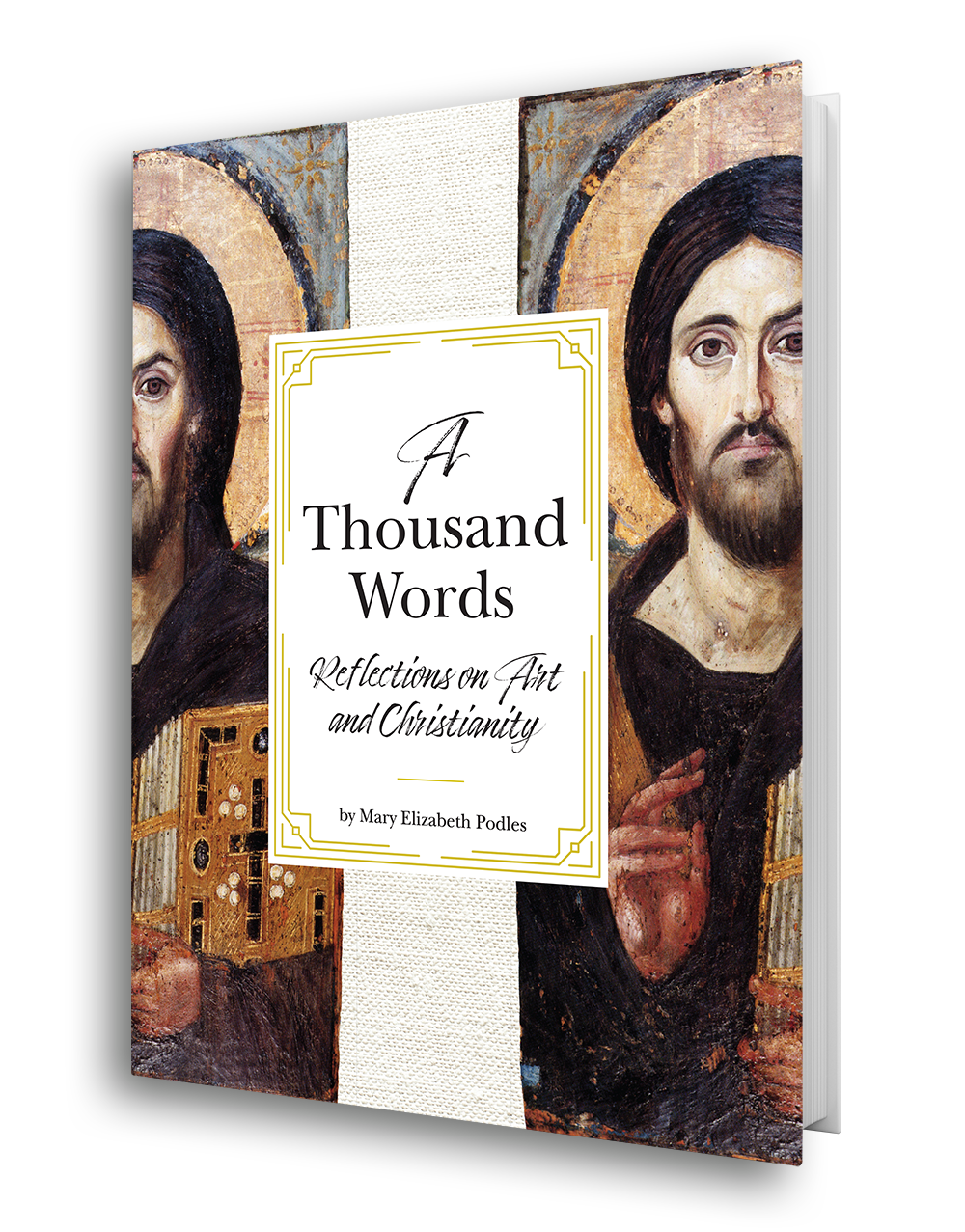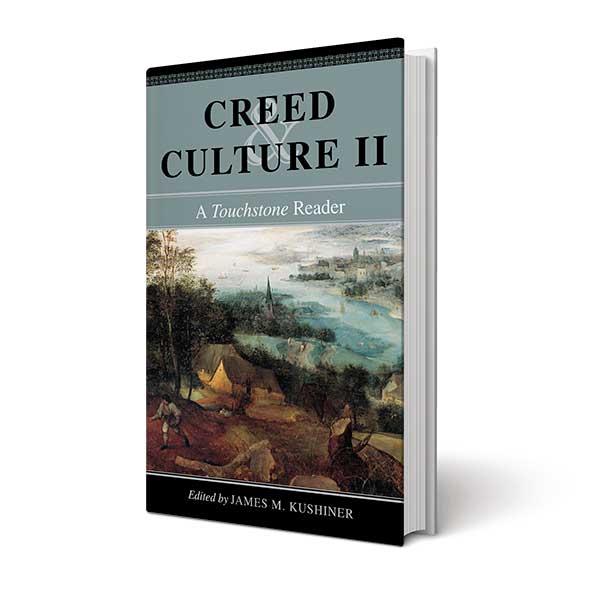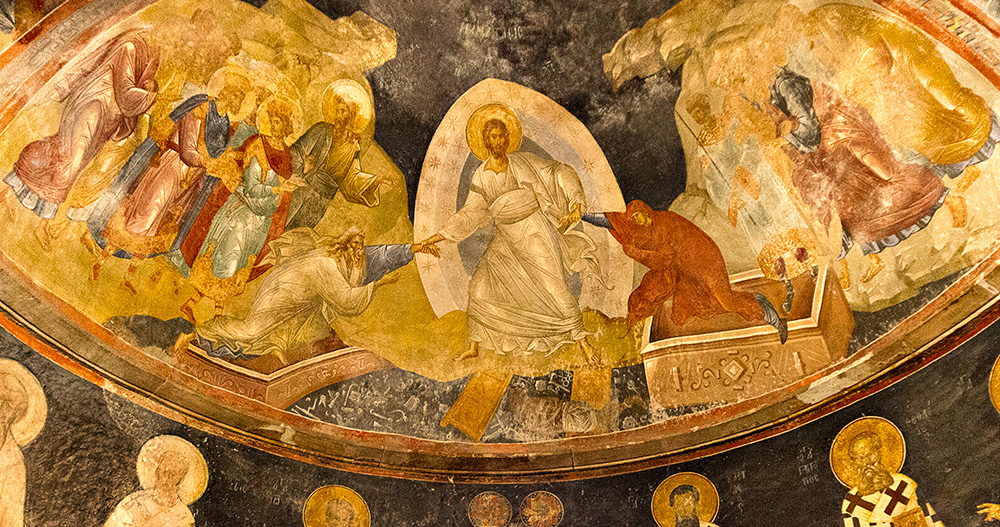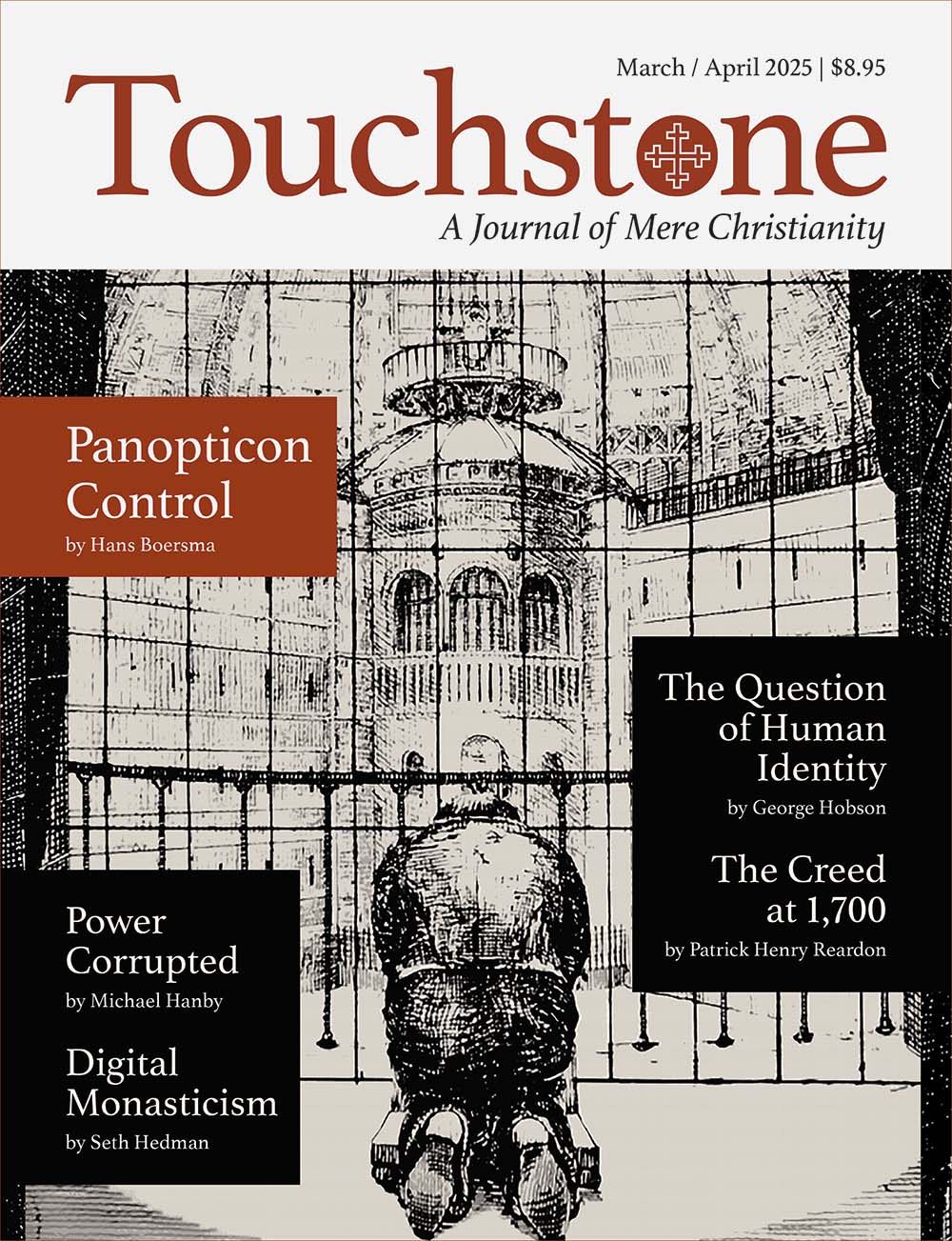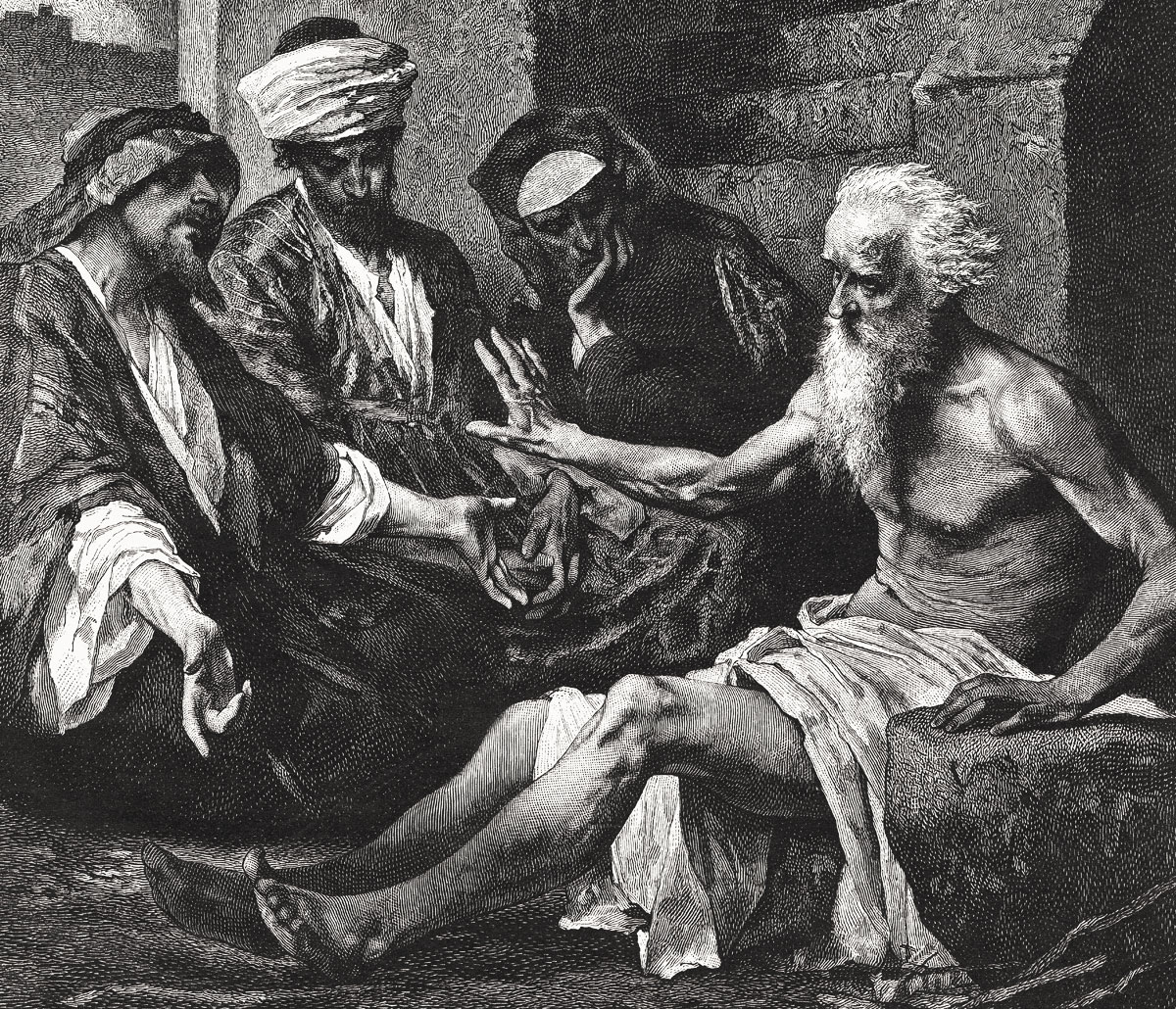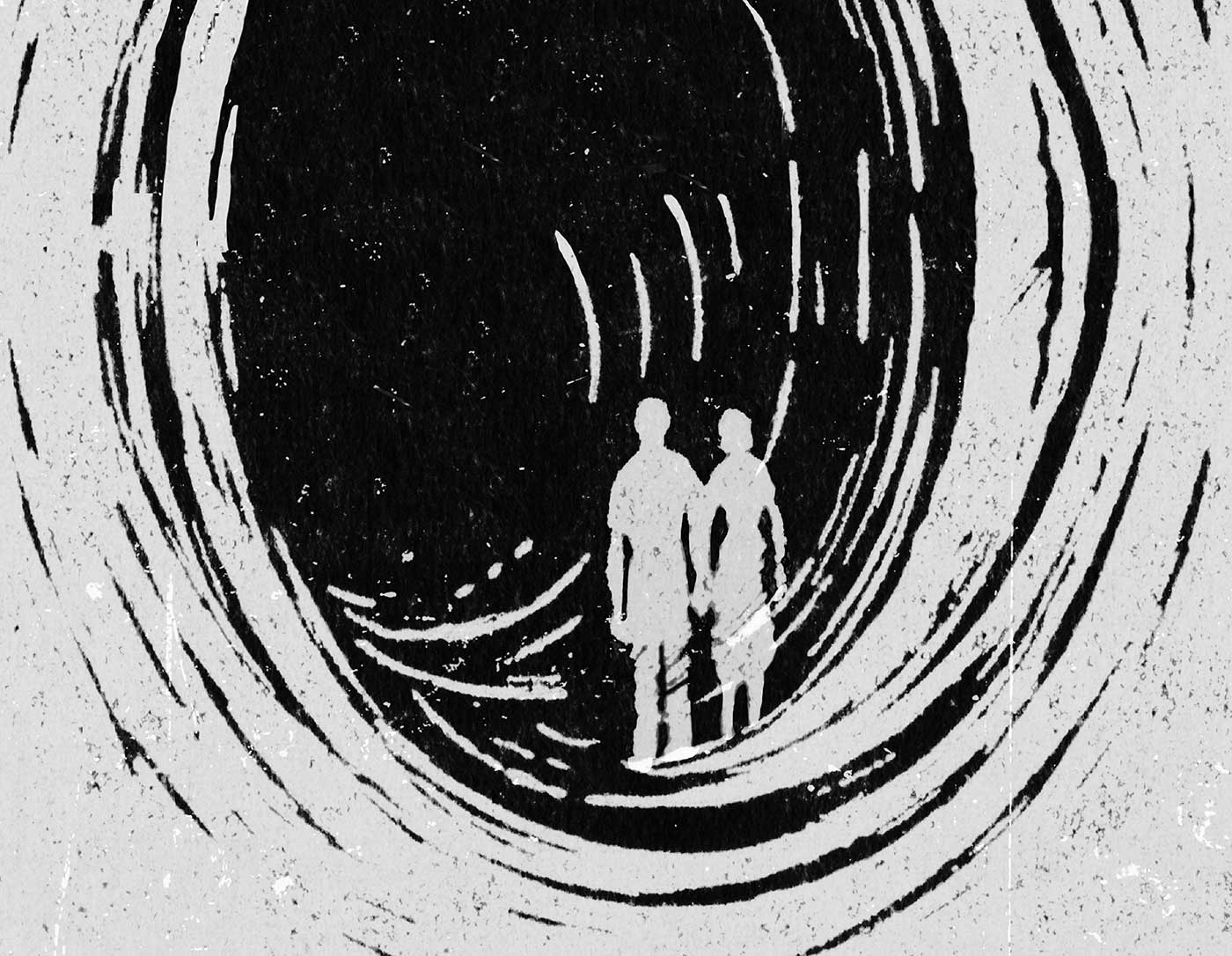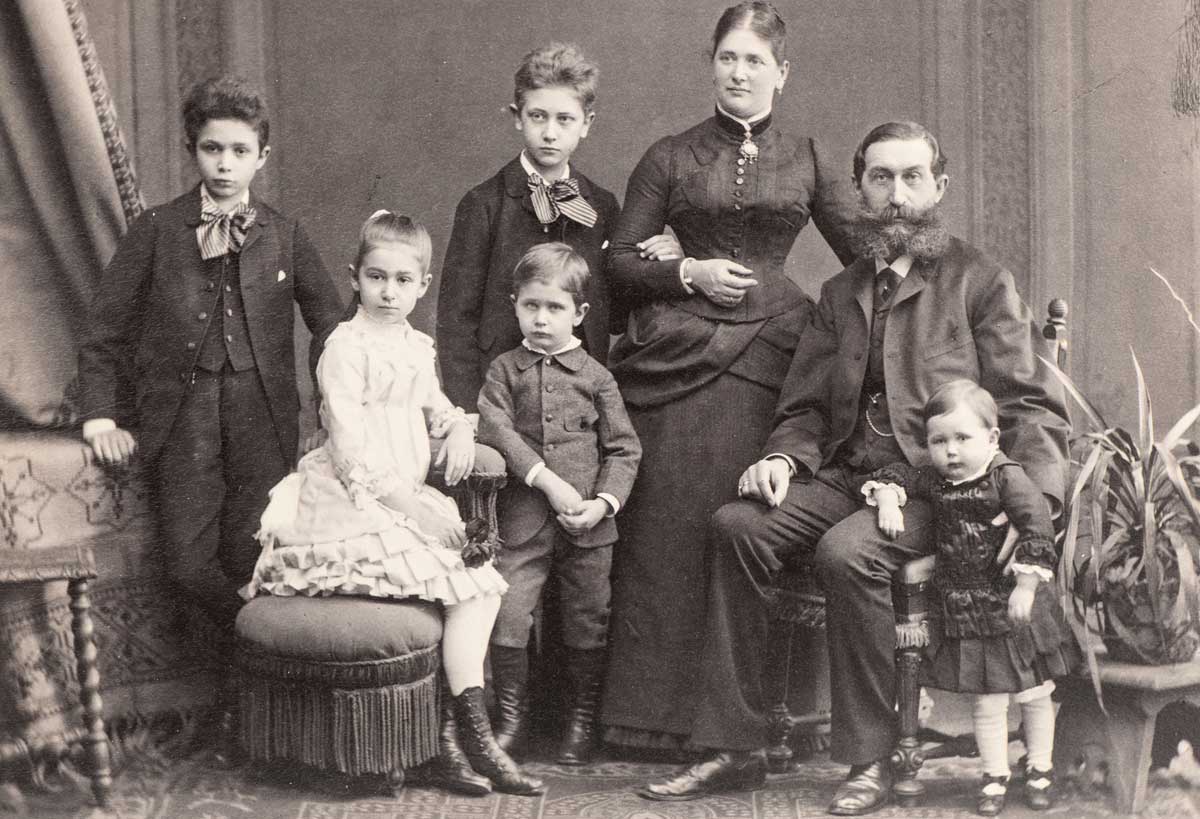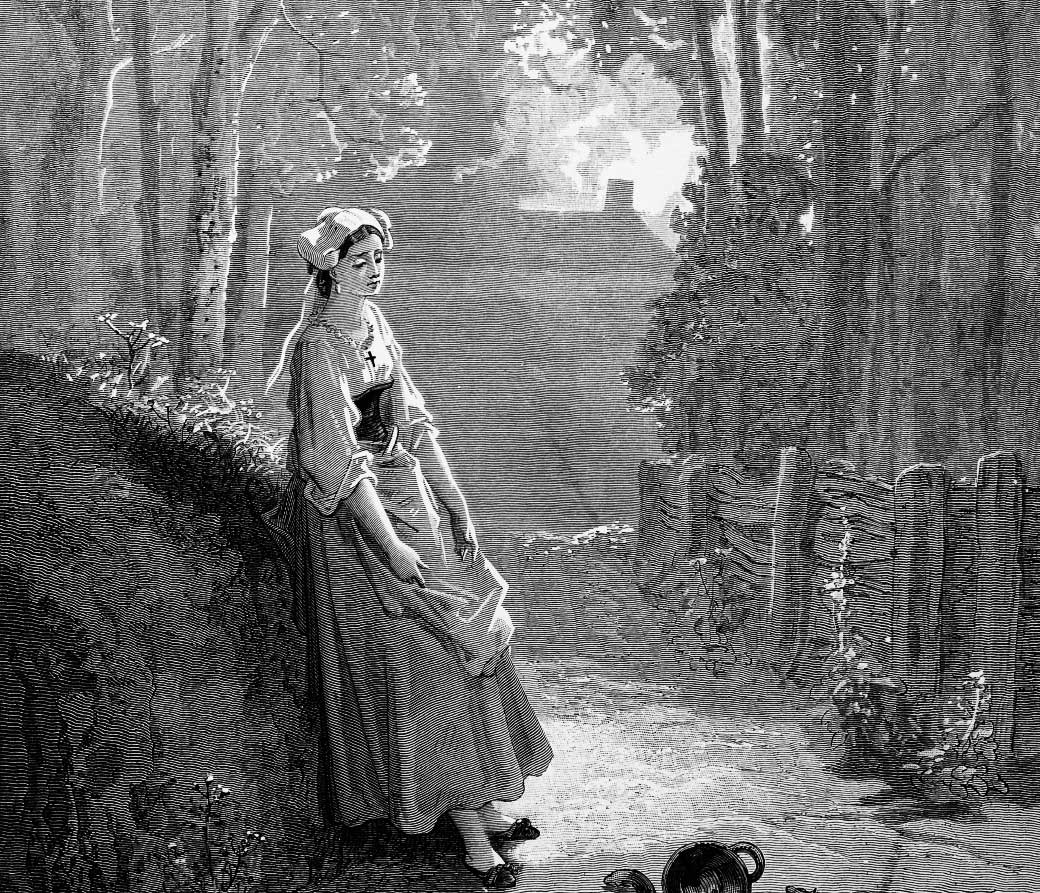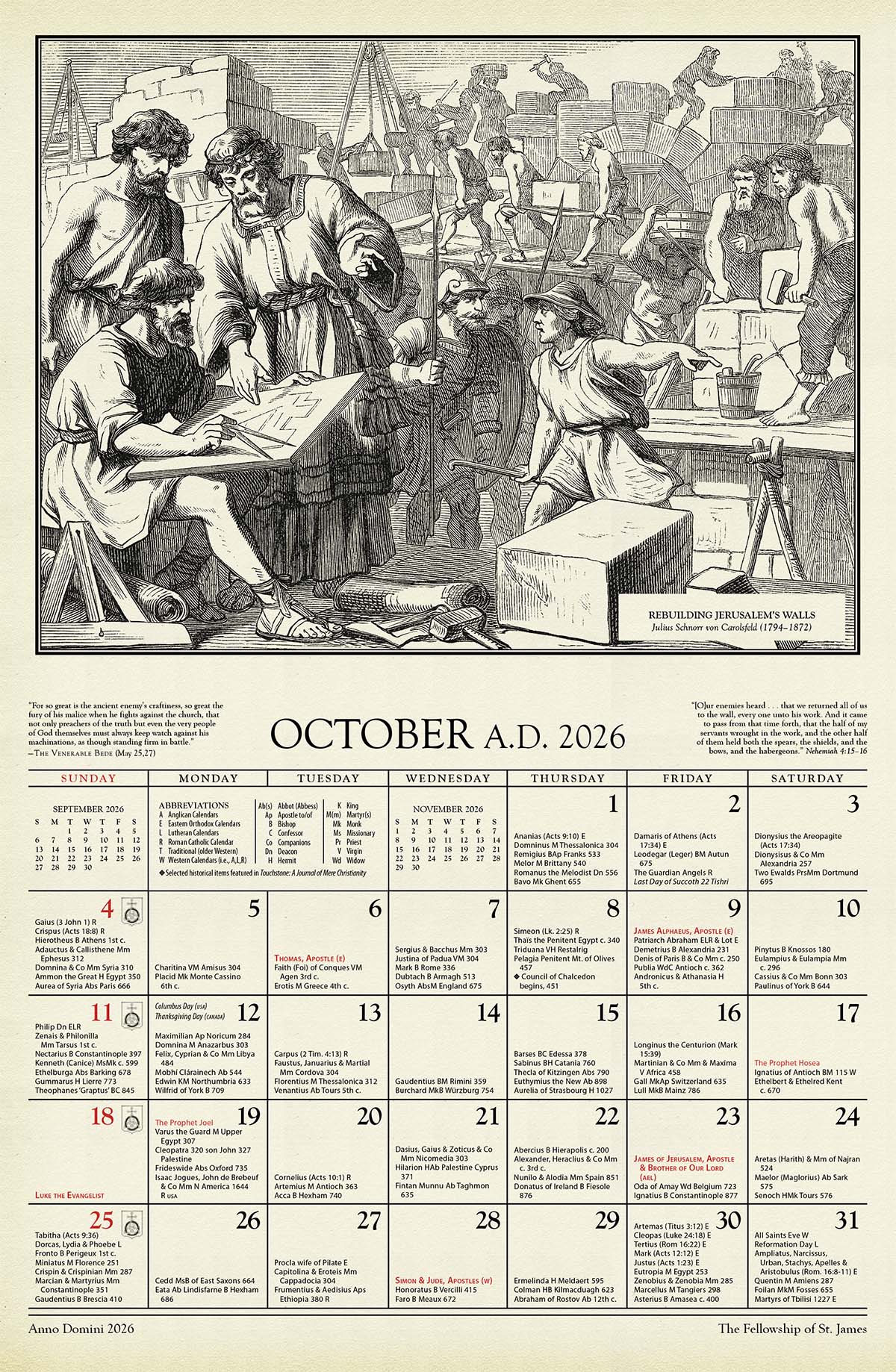The Question of Human Identity
The Full Christian Answer to Modernity’s Crisis
Western society today is roiled by the question of identity. Most of us are not scholars with gifts and time to devote to the countless books and studies and endless arguments concerning racism, LBGTQ rights, homosexual “marriage,” transgender polemics, donor sperm and eggs, surrogacy, family breakdown, pornography, increasing divorce, declining population, person theory, abortion, euthanasia, hate speech, and the freedom of religion. We are aware simply that everywhere we turn, we are confronted by venom, dissension, accusation, and conflict. Everyone’s assertion of his rights takes precedence over all other considerations. Sober and honest rational debate has become rare indeed. Confusion is ubiquitous.
The Church’s view of human identity needs to be made clear, for many Christians are as confused as their unbelieving friends. This essay proposes to look at a number of the key anthropological texts of the Bible in an effort to set out a simple, coherent Christian vision of human identity that will be helpful, theologically and pastorally, as we seek to present the gospel to a distraught and agitated world.
Our Created Human Identity
Our first text is Genesis 1:27–28:
So God created man in his own image, in the image of God he created him; male and female he created them. God blessed them and said to them, “Be fruitful and increase in number; fill the earth and subdue it. Rule over the fish of the sea and the birds of the air and over every living creature that moves on the ground.”
This text presents a mythical vision of creation, a revelation, through the power of imagination, of universal reality and deep truth we could not know otherwise. Two points need to be made here: (1) It is the male and the female together, sexually complementary and of equal dignity, who are created in the image of God, and the first commandment they receive is to procreate and take dominion over the rest of God’s creation. This is our primary human identity and our vocation. Any notion that a homosexual union, intrinsically sterile, might have a God-given legitimacy, is ruled out. (2) Man (in both sexes) is created in the image of God; this is the ground of human dignity and of any rights we may legitimately claim. But man is not by nature, in himself, the image of God. Only Jesus is by nature the image of God (Col. 1:15; 2 Cor. 4:4).
The second text is Genesis 2:7:
The Lord God formed man from the dust of the ground and breathed into his nostrils the breath of life, and the man became a living being.
The other animals were also “living creatures” (Gen. 1:20,24), but they lacked the God-breathed spirit of life that made of Adam the image of his Creator. Adam was a different order of being from the other animals, related spiritually to God his Creator.
The third text is Genesis 2:20b–24:
But for Adam no suitable helper was found. So the Lord God caused the man to fall into a deep sleep; and while he was sleeping, he took one of the man’s ribs and closed up the place with flesh. Then the Lord God made a woman from the rib he had taken out of the man, and he brought her to the man. The man said, “This is now bone of my bones and flesh of my flesh; she shall be called ‘woman,’ for she was taken out of man.” For this reason a man will leave his father and mother and be united to his wife, and they will become one flesh.
This creation text, as distinct from the first, which simply places the two humans before us side by side, reveals the ontic intimacy of the man and the woman, to be consummated in marriage. They are two distinct persons, sexually differentiated; they are not androgynous, but they are essentially united in their human nature.
It is Adam who has the originating authority in the relationship; it is he who, before the creation of his helper, was given the task of naming the animals; it was he who, later, named his wife “Eve,” not she who named him “Adam”; it was to him that God said they must not eat of the tree of the knowledge of good and evil. But without her, he is alone, with no companion suitable for him—different from him yet of his kind—and God considers that this is “not good” (Gen. 2:18). At the sight of her, he is filled with joy. She is his organic helper, indispensable to his fulfillment as a man, as he is indispensable to her as her head and covering and protector. Through his overarching care for her and for their family, she will have the freedom to fulfill herself as a woman, primarily, if not exclusively, through procreation and motherhood.
Created in the image of God, who is love, Adam is made to love, to pour himself out to another, as God—Father, Son, and Holy Spirit—has poured himself out in creating the world. And, drawn from Adam’s body, Eve is, as it were, organically made to love him in return. Love is a matter of relationship—one cannot love alone. Their sexual union will affirm and consolidate their love and enable them, in obedience to God’s command, to “be fruitful and increase in number” (Gen. 1:28).
Effects of the Fall
Our fourth text, Genesis 3:1–7, recounts the Fall. God has informed Adam, and Adam has informed Eve (Gen. 2:15–17; 3:3), that he does not want them to eat of the tree of the knowledge of good and evil. The heart of the serpent’s temptation is in verses 4–5, where Eve is seduced by the vision of knowledge and its power. The serpent represents a real figure, Satan, a fallen angel, who will one day tempt Jesus and fail.
With Eve, he succeeds. If she eats of the tree, the serpent tells her, she will have the knowledge of good and evil and will be like God. She (and Adam) will be able to decide for herself what is good and what is evil. Self-consciousness, pride, and ambition, along with a fleshly craving, swell within her, and she eats. Original sin is disobedience to God’s command, arising from the hunger to be like God. It issues in self-justification, accusation, jealousy, the quest for power, and violence, as Scripture and history show us. Modernity/postmodernity, with its scientific and technological prowess, is bringing these effects to their culminating point—the pretension that man is not only like God but is God; there is no such being as a transcendent Creator.
A point rarely noted is that Eve was vulnerable to temptation because neither she nor Adam was acting according to his or her proper marital role, roles that were precisely delineated millennia later by the Apostle Paul in his letter to the Ephesians (5:21–33). Adam was “with her” when Eve was tempted (Gen. 3:6), but he failed to protect her by exercising his role of spiritual authority. He could and should have told her not to heed the serpent’s lie. For her part, Eve failed to submit to his authority by deferring to him and the command he had received from God not to eat from the tree. In this sense, she failed to help Adam fulfill his masculine, husbandly calling.
Thus, their unity was already compromised before the Fall; after the Fall, it was broken. Adam blames Eve; Eve blames the serpent. Adam’s initial joy in Eve’s presence is replaced by accusation, and henceforth he will “rule” over her, not primarily to protect but to dominate and control her. Mankind has fallen into recrimination, brutality, and corruption. Eve’s first-born son, Cain, will murder her second-born, Abel. The rest is history.
With the Fall, men and women are separated from intimacy with their Creator. The image they bear of God remains; their relation with him subsists, but the image is inverted and becomes negative. Alienation, shown by the fear Adam and Eve experience when God calls to them in the garden (Gen. 3:9), replaces love. Self-focus replaces God-focus. Such self-focus takes the form of idolatry of created things until, with modernity, it becomes self-idolatry per se, coupled with intentional atheism. The gifts of reason, will, freedom, and conscience, integral to man made in God’s image, are still in place—God does not withdraw them—but henceforth their positive use, which, by God’s grace, will be rightly deployed to take dominion over creation and build civilization, will often be perverted by the exploitative drive for power, lawless pleasure, and self-glorification, as evidenced in the centuries following Adam’s day and in the scriptural account of the tower of Babel (Gen. 11). Dominion—the mandate and positive expression of the divine image—will, all too often, be perverted into domination.
Such is human identity as we know it from history. We cannot rightly understand human identity without reference to the Fall. Man as created has fallen out of joint and will henceforth act sinfully, that is, egocentrically, even if a capacity for love and justice and an inner longing for divine joy, peace, and eternal life remain constant in his soul. Conduct that is unnatural in the light of the creation narrative, like the practice of homosexuality, will become natural in the sense that disobedience to God’s natural law will become normal. True knowledge and love of the one true God, the Creator, will be out of mankind’s reach. Man-focused counterfeits of life in God, which is rooted in universal human dignity and expressed in justice and joy, will crop up all through history. Communism and sexual libertarianism are examples from modern times.
Fallen Man’s Delusions
Before moving to the next stage in the history of human identity, which concerns God’s offer of redemption, we need to insist that both creation and Original Sin—the Fall—as revealed in the Scriptures, are fundamental aspects of the Church’s understanding of human identity and the problem of evil. Christians cannot claim to know precisely how these realities came to be, but to obfuscate either is to fail to understand the real world. We do not create ourselves or the rest of nature, so we cannot with impunity try to remake nature or ourselves in our own image through technological manipulation. Gnostic postmodernists claim that this is possible by absurdly asserting, for example, that gender and male/female sexual distinctiveness are human constructions and that homosexuality and homosexual “marriage” are as legitimate and healthy forms of human intimacy as heterosexuality and marriage between a man and a woman, whose purpose, as we saw with Adam and Eve, is procreation and complementary love and support.
The philosophical proposition that fallen man is naturally good and that society as such is somehow the cause of an individual’s corruption; or the pretension that we are able, by ourselves, through political, economic, sexual, or technological revolutions, like transhumanism or artificial intelligence, to usher in some form of utopia—these are foolish illusions, as is the mindless assertion, common in our day, that tradition or family or patriarchy or religion or morality are, in themselves, oppressive and constitute the cause of humanity’s woes and unhappiness.
In deciphering the tragedy of human history as well as the glory of human achievement, the Church, affirming creation and Fall as revealed truths of primeval reality, stands on far more solid ground, rationally speaking, than does the secularist who denies them. This is equally true when the Church (along with increasing numbers of cosmologists and biologists) stoutly rejects materialistic reductionism and the thoughtless ascription of the astounding order and rationality of the universe, and of the origin and structure of life within it, to sheer chance-plus-time.
An Unprecedented Reality
Having created the world and life and mankind, and then seeing men disobey his commandment and fall into fear, distrust, and violence, God, out of love for what he made and determining to realize his primordial project for creation, now moves to redeem humanity. A hint of his grace is given in Genesis 3:21, when God provides garments of skin to cover his human creatures, who have lost their innocence and know shame. In time, the Lord calls Abraham (Gen. 12), makes a covenant with him (Gen. 15), and creates a people for himself that will be the carrier of his Name and eventually the bearer of humanity’s Savior. Jesus Christ, the very Word of God, through whom the world was created, becomes incarnate in the womb of a woman, a descendant of Eve. God, the Creator of time and space, enters time and space in order to save mankind, his created and greatly beloved image, from sin and death.
God’s next move is to liberate his chosen people from slavery in Egypt, thus providing a historical image and analogy of the liberation of mankind as a whole from slavery to sin, which Jesus would accomplish centuries later. This is followed by the declaration of his Law through Moses, most succinctly in the Ten Commandments (Ex. 20). What follows in the Old Testament is a sustained account of how even God’s chosen people, the Hebrews, graced by his presence and his enduring covenant, are hardly more able than the pagan world around them to obey his Law. As St. Paul points out centuries later, the Law actually functions to reveal sin and man’s fallen nature (Rom. 5:12–13,20; 7:7–25; 1 Cor. 15:56–57).
Man in his fallen nature, Paul affirms, is “unspiritual, sold as a slave unto sin” (Rom. 7:14). From the time of Adam to the time of Christ, this has been unchanged. In Christ, and in Christ alone, is humanity’s redemption. Jesus Christ is the very Image of God (2 Cor. 4:4; Col. 1:15; cf. Heb. 1:3), the Son of God made man. Through his incarnation, passion, resurrection, and ascension, followed by his gift of the Holy Spirit, an unprecedented possibility opens up for mankind: the recovery, for individual human beings, of what was lost in the Fall, the positive image of God and intimacy with their Creator.
This could happen through the experience of the new birth of which Jesus speaks in John 3:7 and Peter in 1 Peter 1:23. By receiving Christ and believing in his name, one could become a “new creation” (2 Cor. 5:17; Gal. 6:15), a son or daughter of God (John 1:12–13). A moving expression of this truth is found near the end of John’s Gospel, when Jesus says to Mary Magdalene: “Do not hold onto me, for I have not yet returned to the Father. Go instead to my brothers and tell them, ‘I am returning to my Father and your Father, to my God and your God’” (John 20:17). It should be noted that God is occasionally called “Father” in the Hebrew Scriptures, but this is in reference to him as Father to the nation of Israel, not to individual Jews (Jer. 31:9; Is. 63:16; 64:8). Personal sonship is the fruit of the new covenant in Christ.
This was a new reality in the history of mankind. Through Christ, who took man’s sin and death upon himself and then was raised again to new life, a new identity emerged as a universal human possibility, available not only for the Chosen People, the Jews, but for all human beings: an individual person, through faith in Christ the Redeemer, could find himself once again in intimate positive communion with his Creator, knowing and loving God as Adam and Eve had done before the Fall. The Church, the Body of Christ, made up of the fellowship of believers, was born: an entity distinct from the rest of humanity, not through any greater natural virtue of its members but through their recognition of sin followed by a movement of repentance and an act of faith in Jesus Christ, the Son of God, who had taken on flesh to open for mankind a way back to God the Father.
This unprecedented reality is expressed simply by the Apostle Paul in Galatians 3:26–28:
You are all sons of God through faith in Jesus Christ, for all of you who were baptized into Christ have clothed yourselves with Christ. There is neither Jew nor Greek, slave nor free, male nor female, for you are all one in Jesus Christ. If you belong to Christ, then you are Abraham’s seed, and heirs according to the promise.
A parallel text in Colossians 3:11 adds “Scythian” and “barbarian” to the social categories transcended in Christ. These categories are not eliminated, but, for their members who are in Christ and constitute the fellowship of the Church, they cease to be cultural barriers and sources of enmity and opposition. Through participation in Christ’s cross and resurrection, people from any background and with any social identity may experience divine love and unity and so, with all their differences, enjoy true spiritual and fraternal communion. Their differences are experienced as enrichments rather than as offenses and threats. While Christians have, regrettably, rarely lived in full accord with this possibility, some have done so faithfully over the ages, with incalculable benefits to society. The essential witness of the Church remains true and effectual even if her members often fall short of the fullness of God’s grace in Christ.
Advancement in Holiness
The last point to be made in this discussion of human identity concerns the matter of steady advancement in conformity to Christ-the-Image-of-God on the part of those now called “heirs of God” (Rom. 8:17), who have recovered the primordial reality and dignity of their identity as created in God’s image. Paul writes in Colossians 2:20 that the Christian “has died with Christ to the basic principles of this world.” What the apostle calls the “old man” or the “flesh”—not the body as such but the self-focused orientation of fallen natural man—has been put to death in Christ, who has borne human sin in his flesh on the cross. Baptism, signifying death and rebirth, is the sacramental expression of this new reality. Christians are justified and sanctified in Christ and incorporated into his Body, the Church (1 Cor. 1:2; 6:11; Rom. 5:1–2).
But if their position in Christ is one of holiness, their actual moral condition is far from holy. The obedient Christian’s life will be a process of increasing in sanctification, so that he may become who he actually is spiritually through God’s grace in Christ. “Work out your own salvation with fear and trembling,” writes Paul to the Philippians (2:12), and to the Thessalonians: “It is God’s will that you should be sanctified: that you should avoid sexual immorality; that each of you should learn to control his own body in a way that is holy and honorable, not in passionate lust like the heathen, who do not know God” (1 Thes. 4:3–5). And he adds in conclusion: “May God himself, the God of peace, sanctify you through and through. May your whole spirit, soul, and body be kept blameless at the coming of our Lord Jesus Christ” (1 Thes. 5:23).
The new life to which the Christian is called requires obedience to God’s written and incarnate Word, discipline, perseverance, humility, and courage. Such behavior is possible as it is worked out through the power of the indwelling Holy Spirit. It is the Christian who acts, but it is the Spirit who inspires the good actions and conforms the person to Christ, whose nature indwells him. Christians are to be “transformed by the renewing of their minds,” writes Paul (Rom. 12:2). They accomplish this by “offering their bodies as living sacrifices” (Rom. 12:1), by progressively dying to the remnants of the old nature, the as yet unsanctified motivations and actions that characterized the former life: “if by the Spirit you put to death the misdeeds of the body, you will live, because those who are led by the Spirit of God are sons of God” (Rom. 8:13b).
Identifying with Jesus
By committing their lives to Christ, Christians identify with Jesus on the cross. As they recognize a sin in their lives, they are called to declare it to be dead and to see themselves henceforth as dead to it and alive to new behavior according to the Holy Spirit. Acting thus is to put in practice their identity in Christ and to experience ever-increasing sanctification. Writes Paul to the Romans:
If we have been united with him like this in his death, we will certainly also be united with him in his resurrection. For we know that our old self was crucified with him so that the body of sin might be done away with, that we should no longer be slaves to sin—because anyone who has died has been freed from sin. (Rom. 6:5-7)
Identification with Christ in his death and resurrection, and the concrete application of this identity to our ethical behavior, is the key to sanctification and the continual healing from sins and soul-wounds suffered in the past. The Holy Spirit may bring such sins into the light, exposing their roots and the connections between them in order that they may be dealt with specifically in confession and prayer. Pastoral assistance from a priest or pastor, or simply from fellow lay Christians, is often rendered in this regard. What is called “inner healing”—vital to a fruitful Christian life and to the vitality of any parish or community—turns on this truth and practice. Christians have forgiveness through Christ’s death and resurrection, and they are able to forgive others for the wounds they have suffered, and to forgive themselves as well for their own sins, by dying with and in Christ to the pride, bitterness, lust, sexual immorality, jealousy, fear, covetousness, greed, rage, self-righteousness, contempt, hatred, and condemnation that may have marked their past, as well as to the self-hatred and self-pity that often accompany these and other sins, for which the Spirit gives them repentance. The more specific the object and focus of this repentance and this putting to death, the more powerful the deliverance, the inner transformation, and the new-found freedom and testimony to God’s glory.
And so the Christian, as a member of Christ’s Body, grows progressively in humility, inner peace, and holiness and moves toward the fulfillment of his vocation as a human being, a human being redeemed in Christ and called to love. By this means Christians will perform all kinds of good works and have a powerful impact on the society they move in. St. Paul writes conclusively to the Roman church:
And we know that in all things God works for the good of those who love him, who have been called according to his purpose. For those God foreknew he also predestined to be conformed to the likeness of his Son, that he might be the firstborn among many brothers. And those he predestined he also called, those he called he also justified, those he justified he also glorified. (Rom. 8:28–30)
Such glorification in and through Christ is the destiny to which mankind is called, the ultimate expression and fulfillment of human identity.
George Hobson is a poet and retired priest in the Episcopal Church of America who has spent many years working in the ecumenical/charismatic movement in France. He earned a doctorate in theology at Oxford University in the 1980s and in the 1990s served as Canon Pastor at the American Cathedral in Paris. He taught later in theological colleges in developing countries, including Rwanda, Haiti, Pakistan, and Armenia. He has published six collections of poetry and two books of theological/social analysis.
subscription options
Order
Print/Online Subscription
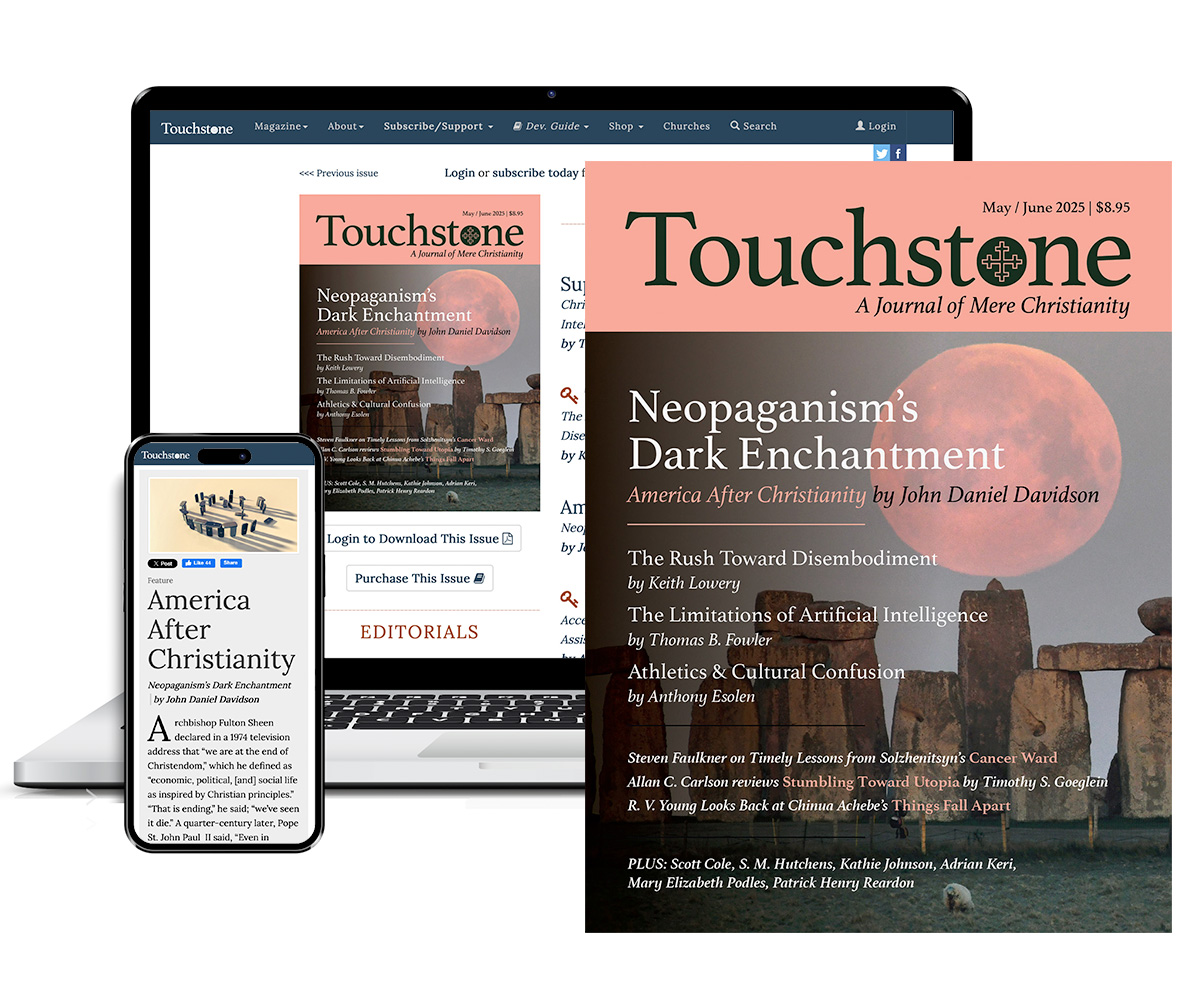
Get six issues (one year) of Touchstone PLUS full online access including pdf downloads for only $39.95. That's only $3.34 per month!
Order
Online Only
Subscription

Get a one-year full-access subscription to the Touchstone online archives for only $19.95. That's only $1.66 per month!
bulk subscriptions
Order Touchstone subscriptions in bulk and save $10 per sub! Each subscription includes 6 issues of Touchstone plus full online access to touchstonemag.com—including archives, videos, and pdf downloads of recent issues for only $29.95 each! Great for churches or study groups.
Transactions will be processed on a secure server.
more on Culture from the online archives

33.1—January/February 2020
Do You Know Your Child’s Doctor?
The Politicization of Pediatrics in America by Alexander F. C. Webster
more from the online archives
calling all readers
Please Donate
"There are magazines worth reading but few worth saving . . . Touchstone is just such a magazine."
—Alice von Hildebrand
"Here we do not concede one square millimeter of territory to falsehood, folly, contemporary sentimentality, or fashion. We speak the truth, and let God be our judge. . . . Touchstone is the one committedly Christian conservative journal."
—Anthony Esolen, Touchstone senior editor



